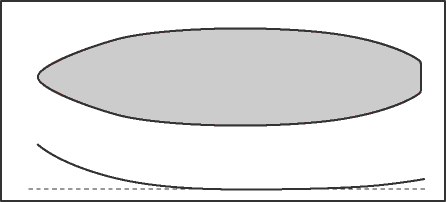

However none of the surf kayaks I've paddled really offered what I was looking for, which was the waveski like performance in a decked kayak. A new boat from "Class V surf dogs" the UFO comes close, but I was looking for something with even more of a waveski hull. So I decided to build my own.
There are lots of resources out there for people who want to build wooden sea kayaks, but not much for people who want to build fiberglass kayaks. There is a good amount of information on building surf and sail boards (see this site for a good index of links). I wanted to put this site up for people who might be interested in building a boat of their own. While it is not a comprehensive set of instructions, it will hopefully provide some idea of what is involved.
 Design can begin at any time and doesn't require any particular tools or supplies, just your head.
Design can begin at any time and doesn't require any particular tools or supplies, just your head.
This design discussion pertains to surf kayaks, building a boat for other types of uses will have different design goals and constraints. Almost every design decision you make is a trade off. To gain an advantage in one way, is to sacrifice some other aspect of the boat's performance.
I was designing a surf kayak that I wanted to be very high performance. In my opinion, the highest performance paddled surf craft out there are the South African and Australian waveskis. But these are not kayaks. I wanted the hull of a waveski (for performance) and the deck of a kayak for comfort and familiarity. Such a design is called a surf boot. The closest thing out there is a boat called Das Boot by Dick Wold. But this boat did not have the performance characteristics of a South African waveski - being based more on the finless, less agressive American waveski. And did not have the rails and hull bottom I was looking for.
To maximize performance on the wave I was willing to give up the following:
I wanted to go with agressive rails and fins - which make it harder to roll and harder to launch. Rounded rails towards the front for easier turning, and progressively harder rails towards the back.
Unlike almost all other kayaks, I wanted the seat close to the stern like on a recent design waveski or surfboard for tighter turning.
I studied the rocker and outline on a custom South African waveski as well as looking at other waveskis and surfboards - the rails and deck I simply shaped by eye and hand. I didn't go for much fancy hull patterns in the way of grooves, concaves, vees, textures etc. I did put a very light concave in the hull towards the nose, and some slight roll in the front part of the boat up to about the thighs which helps in rail to rail transition (but takes away on speed).
While most of the design was done in my head, I did play a little with a CAD program (found it too inflexible) and shaped a small model. I found shaping a small model to be the most rewarding way to visualize ideas.
I have some other comments on costs and materials.